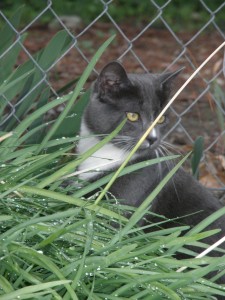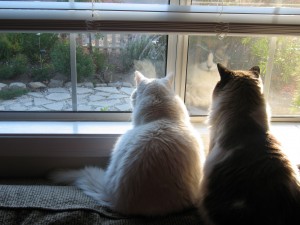
Smokey, the inspiration for this series
Yesterday, we became educated about microchipping cats and this always brings up the debate about cats being kept inside as opposed to roaming outside. I think we all love the vision of a cat in nature—chasing a butterfly in his own backyard, rolling among a bed of tulips, hanging close when you work in your garden, etc. But it has been proven that cats live longer when kept inside under sanitary and healthy conditions.
There are many dangers outside—predators, traffic, poisonous plants, mean-spirited neighbors, poisoned rodents, etc. I’ve known cats who have become accidentally locked in a neighbor’s garage or shed, who stepped into a delivery truck and were carted off to strange lands, or who were frightened by a loose dog and chased to an unfamiliar or hazardous area. I had a cat once who left home because we got a dog. He lived out his life with neighbors across the street.
Some of the complaints we hear about keeping cats inside are the obvious—they claw the

The boys checking out a bunny–on Christmas
furniture, some miss the litterbox, and so forth. Litter boxes are a hassle, but one that a cat-loving human can easily adjust to. Some cats, however, come with problems that can cause havoc in a household—they climb drapes. Some chew plastic (including your electronic cables), others swallow string and ribbon (a disaster for a seamstress or avid crocheter, for example), they shed—oh my how they shed. My mother used to always—I mean always—have a lovely bouquet of flowers in a vase on her dining room table. Not since Smokey moved in, however. This cat knocks the vases over and makes a mess for her to clean up. There are definite adjustments you must make for inside kitties.
And there are also compromises—some of them beautifully done. You can build a screened-in outdoor area attached to your home for the cats who want to sun themselves in nature. Make it as large or small as you want and as elaborate—with plants, cat trees, tunnels, hammocks, etc.





